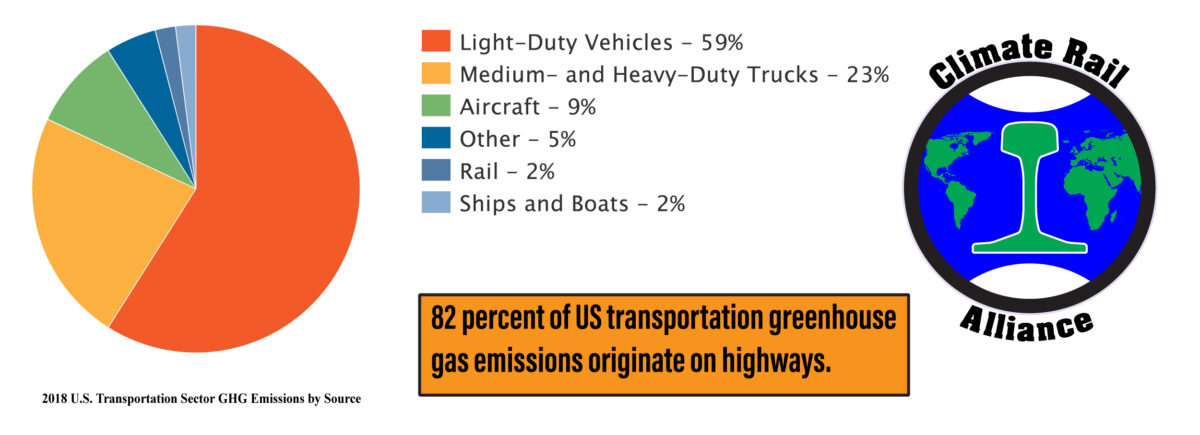In 1993, Washington State embarked on a program of passenger rail improvement, the Amtrak Cascades service, that was intended to be the first step in developing High Speed Rail (HSR) service between Vancouver BC and Portland and between Seattle and Spokane. The plan made almost exclusive use of existing infrastructure and right of way. Seattle – Portland (2 hours 30 minutes) and Seattle-Vancouver BC (2 hours 45 minutes) travel times were intended to be competitive with air. The Amtrak Cascades service stops in 13 intermediate towns and cities (two more than originally planned), providing an attractive alternative to driving on Interstate 5.
The infrastructure program for the service would have also substantially improved freight traffic on the BNSF line between Portland and Vancouver BC.
The problem with the program is…it was never finished. It was never even close to being finished. Completion was to have happened in 2018. As of 2018, about ten percent of the program was complete. Rail freight congestion still abounds. Delays to passenger trains are unacceptable. The travel time between Seattle and Portland will soon be reduced to 3 hours 20 minutes, just barely competitive with driving on Interstate 5 on a bad traffic day. Seattle – Vancouver BC travel time is four hours, ten minutes longer than it was 20 years ago.
The Amtrak Cascades service has effectively been ignored to death.
HSR plans and proposals
HSR is a popular subject all over the country. HSR in Washington has been proposed in several configurations. Most have been merely an express service among Vancouver BC, Seattle, and Portland with little or no intermediate service. Such service would have little effect on greenhouse gas emissions. On a typical day, of 406 arrivals and 449 departures at SeaTac Airport, 40 arrivals and 38 departures represent the traffic that could divert to Vancouver-Seattle-Portland/Seattle-Spokane HSR. That is nine percent of the air travel at SeaTac. Nationally, air traffic represents nine percent of greenhouse gas emissions. This kind of HSR service could reduce transportation greenhouse gas emissions in Washington by about 0.8 percent.
A much better HSR proposal
Cascadia Rail (CHSR) is being heavily promoted in Washington. The promotion includes statements that is an important climate solution.
CHSR proposes service to almost all of the communities served by Amtrak Cascades trains. In that configuration, CHSR will resemble what later stages of the service that began with the Amtrak Cascades program would have been. It will be effective at shifting automobile travel to rail. However, it will do nothing for rail traffic conditions on the BNSF line. Although CHSR proposes to handle freight, the freight it proposes to handle is not the majority of the freight traveling on trucks on Interstate 5 (See page 16-19 here).
The improvements that the Amtrak Cascades program would make to the BNSF line would support fast, frequent truck shuttle trains that would divert substantial truck traffic from Interstate 5. The proposed CHSR plan will not do that.
The CHSR proposal will be configured to eliminate a substantial amount of automobile travel on Interstate 5, as they state.
…but not in time
However, CHSR is not a climate emergency solution.
The CHSR program will take decades for environmental documentation, property acquisition, and litigation before construction can commence. CHSR may be a reality by the year 2050, but certainly not 2030, when emissions must have been reduced by about half.
First things should be first. The complete Amtrak Cascades plan of 2006 should be implemented as quickly as possible. Amtrak Cascades, an incremental program using existing right of way and infrastructure, can be instrumental. Although it was originally conceived to have a 20 year implementation period, with diligent funding and effort, it could be completed by 2030. The incremental nature of the program allows elements of the infrastructure to be utilized on completion, providing constantly increasing shift of traffic from Interstate 5 to rail.
CHSR as proposed, unlike other proposals for HSR in Washington, can be an effective rail transportation service, but time, effort, and funds should be directed toward the Amtrak Cascades service as proposed in the “Long Range Plan for Amtrak Cascades” (2006)
More in The Climate Emergency: Trains-An Effective Response.
TAW
